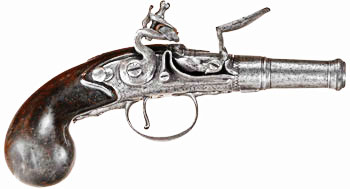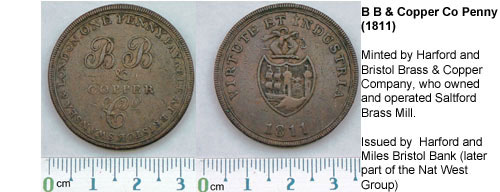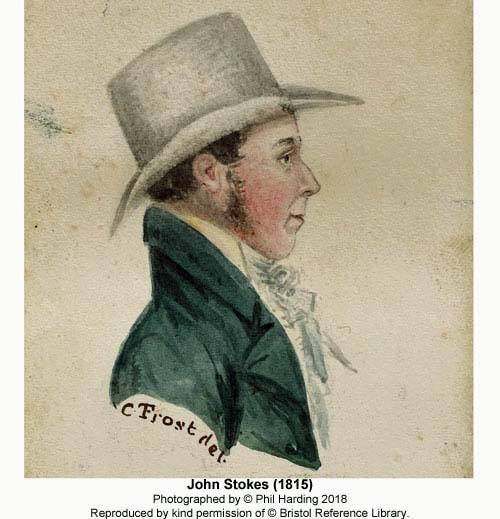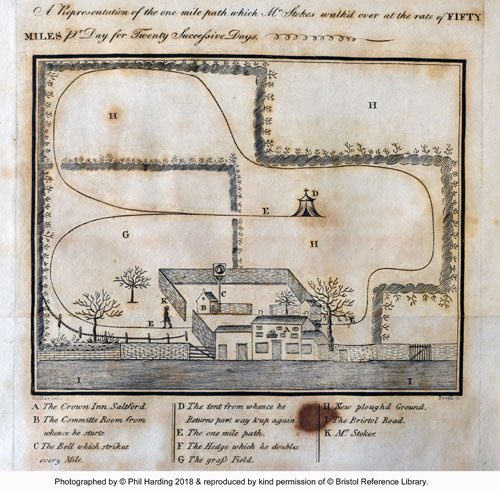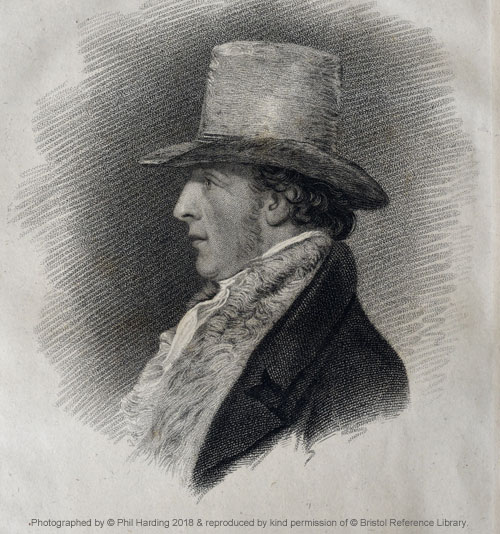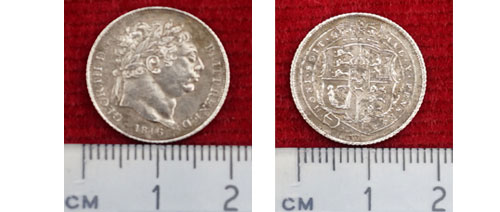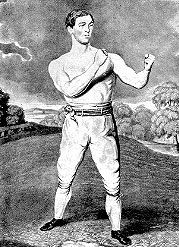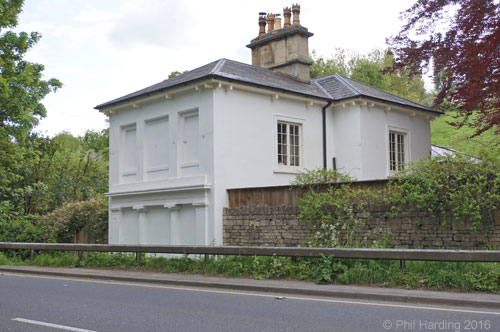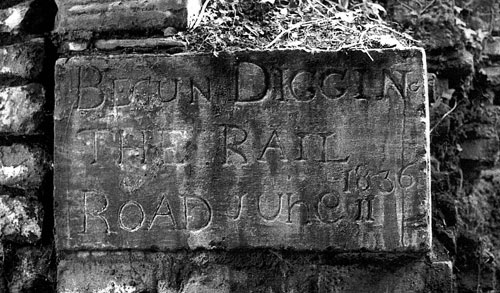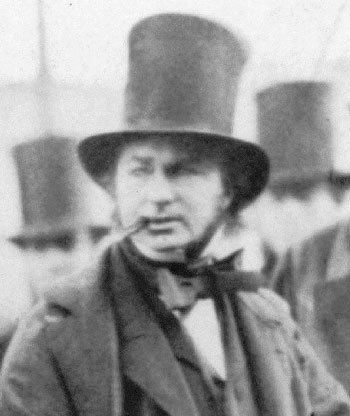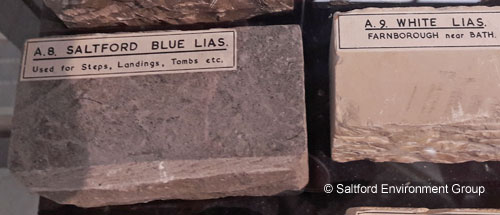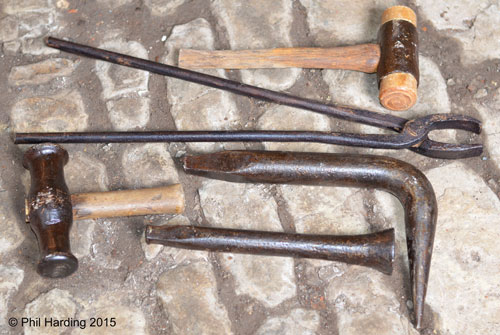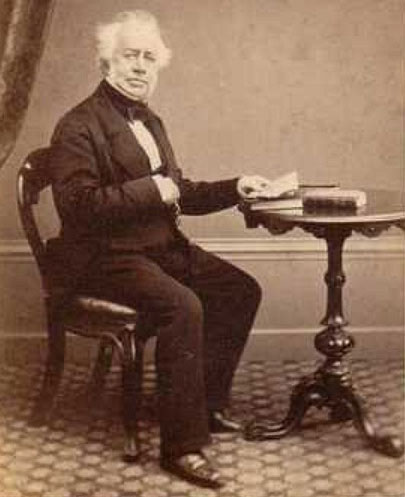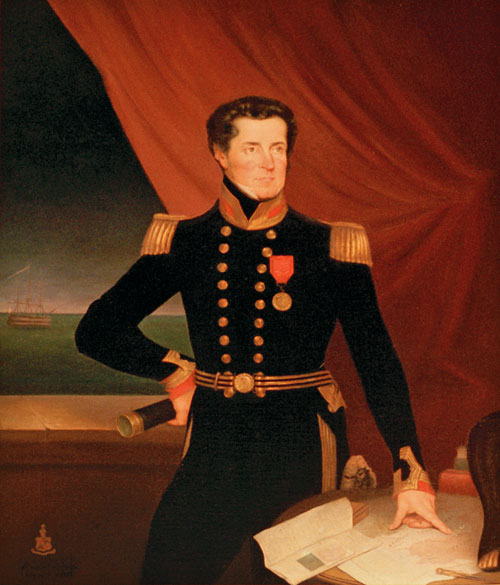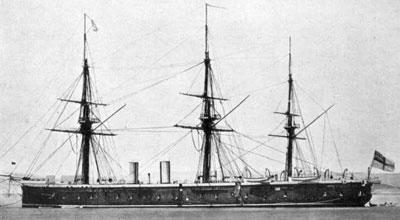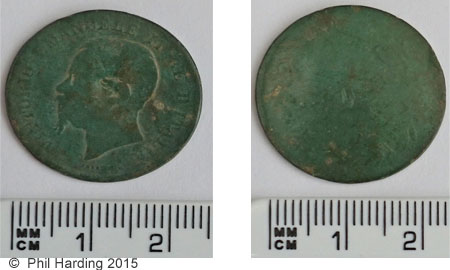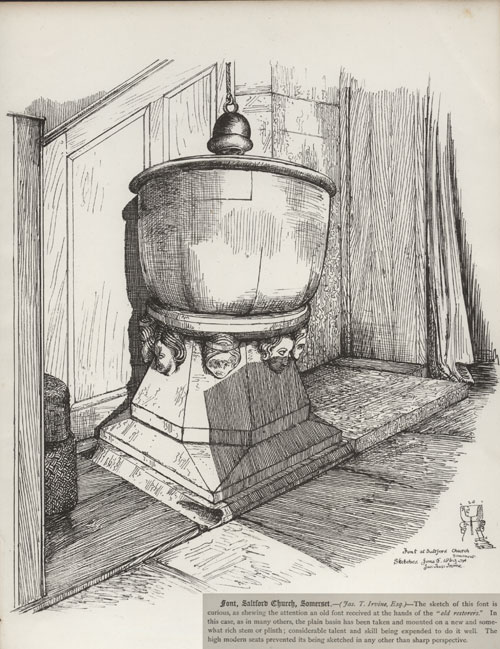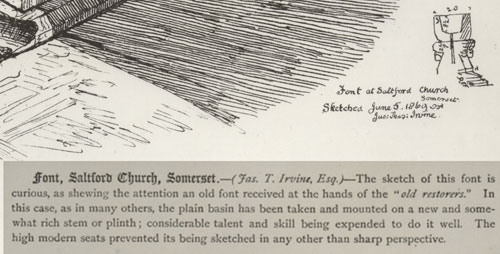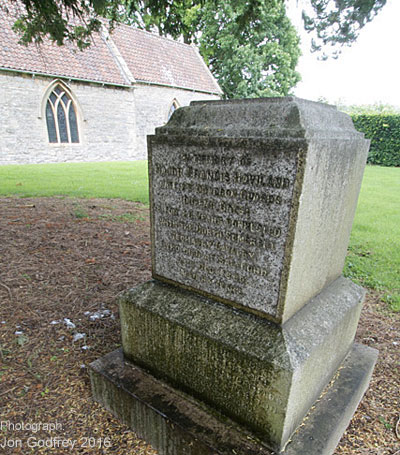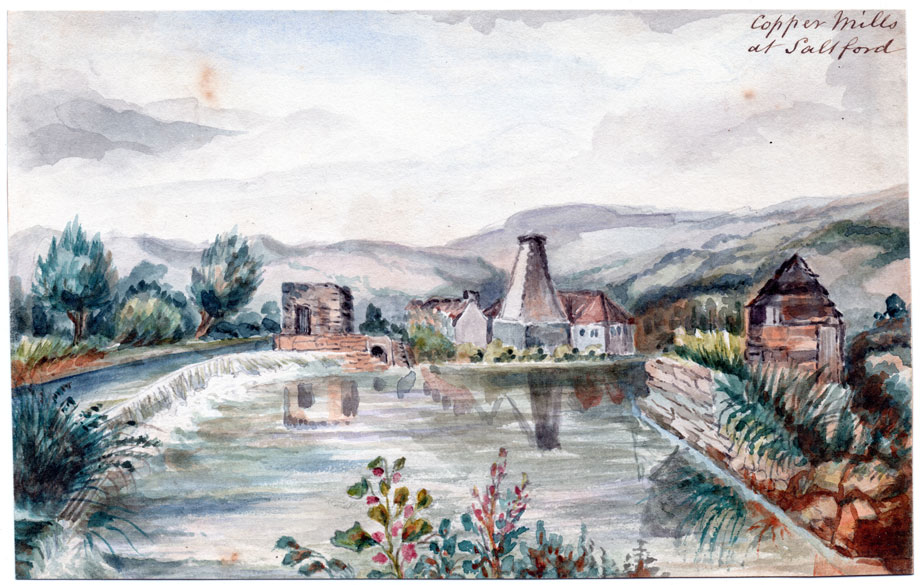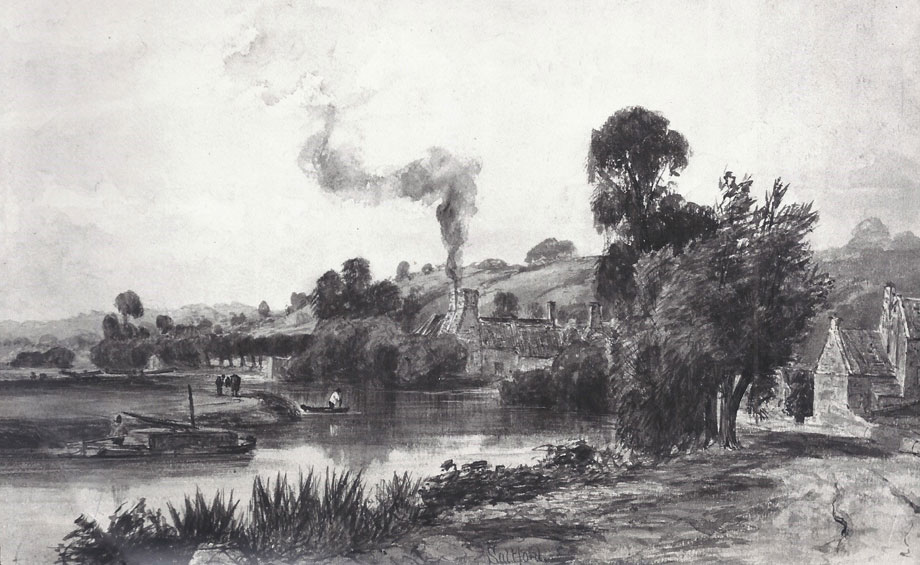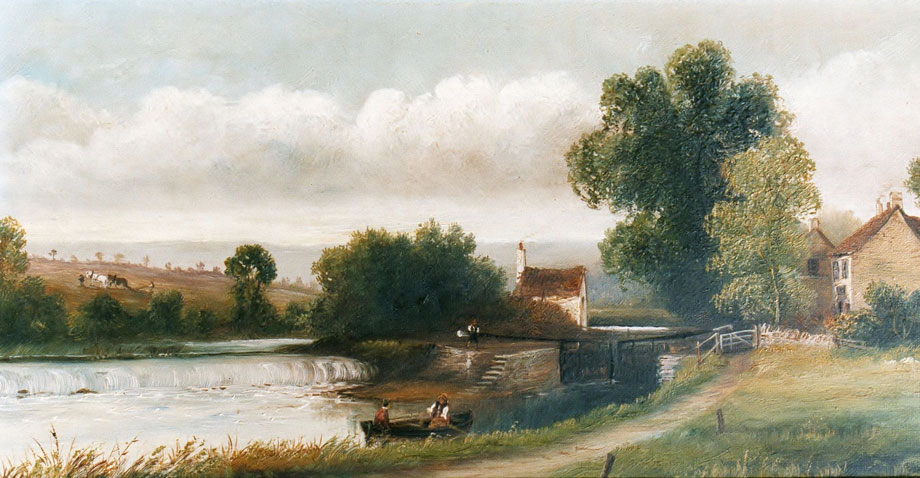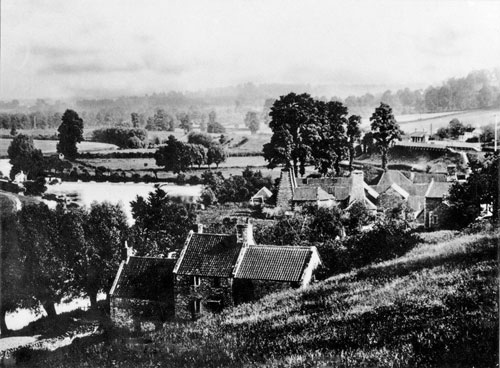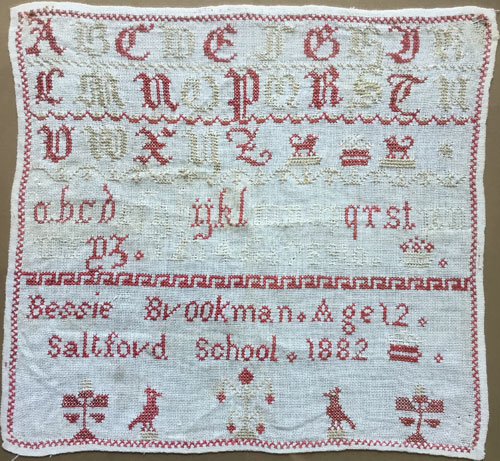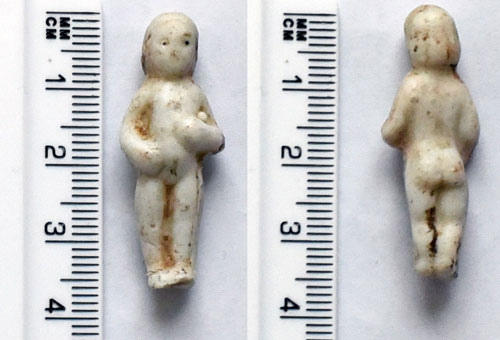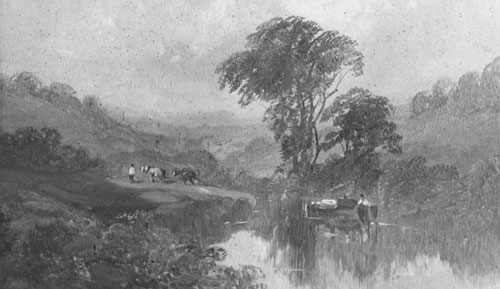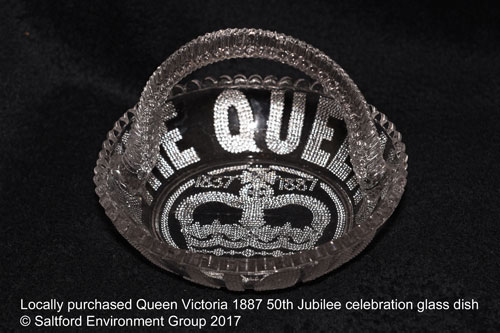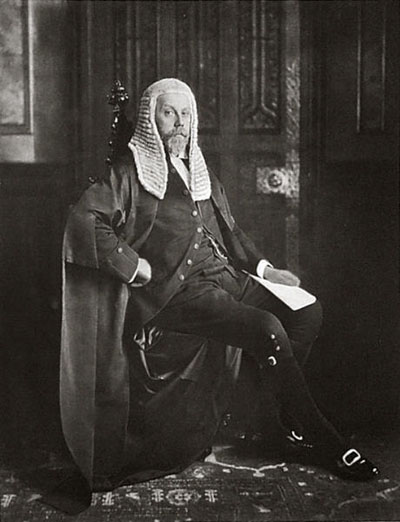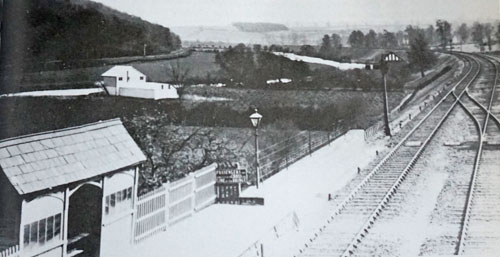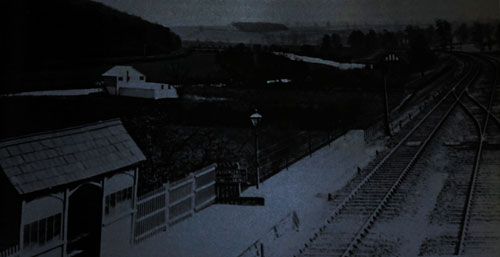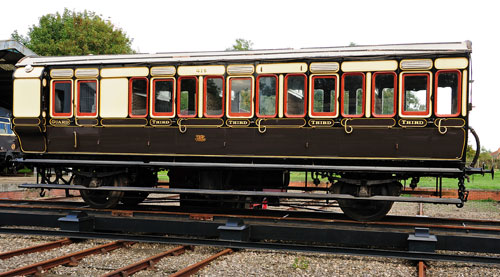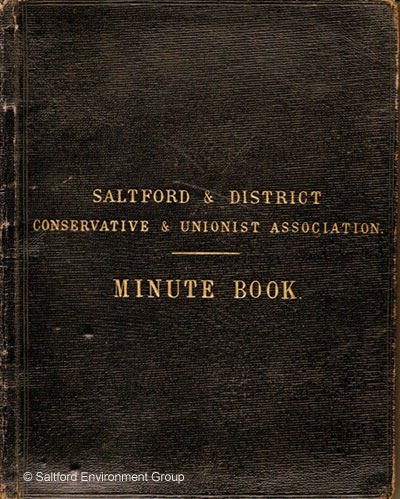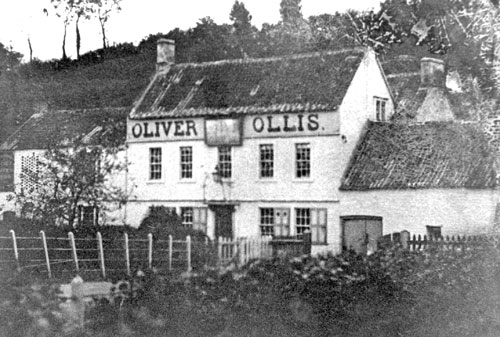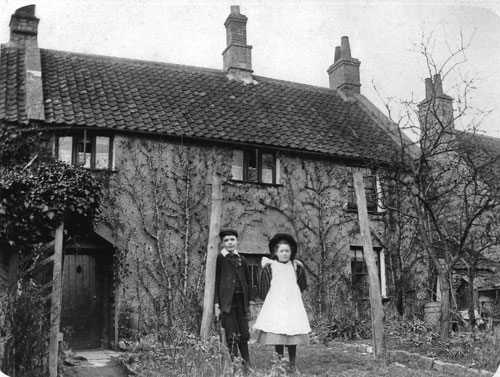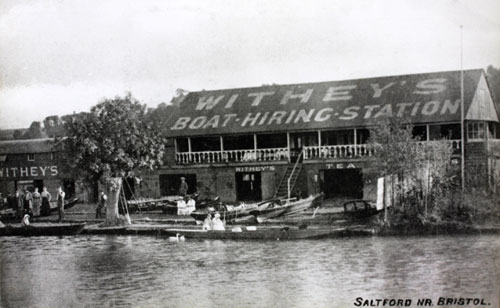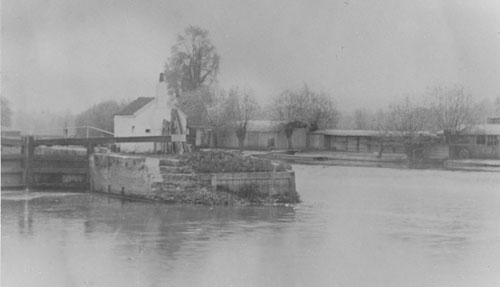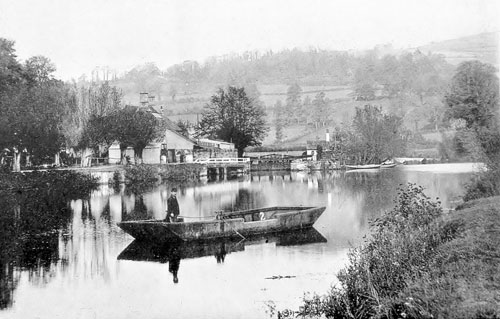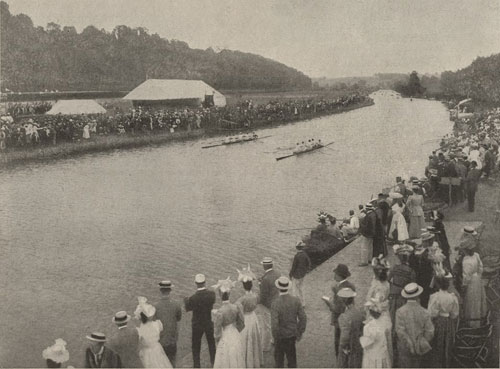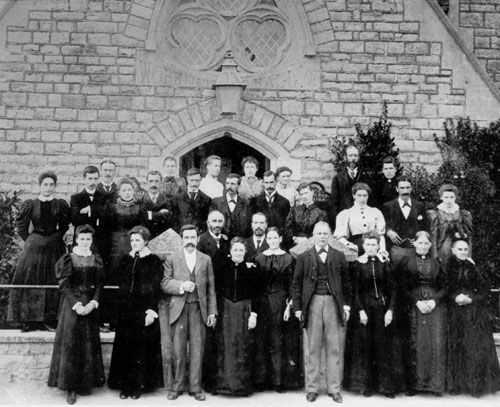|
Saltford Environment Group
|

|
SEG Home > History of Saltford > A - Z > Online Museum > 19th Century The History of Saltford: ONLINE MUSEUM19th CenturyScroll down the page to see Saltford's past including the following special features on this page:- |
This page 19th CenturyNext Pages:-Previous pages:-Also see:- |
1811: Robbed at gunpointThe Times, 20th September 1811:-
Friday afternoon, about three o'clock, as Mr. COLLINS, of Beckington, was returning from Bristol fair, he was stopped between Newton and Saltford, by a single footpad, who presented a pistol at his head, and robbed him of five £1. notes. The footpad; a very stout man, marked with the small-pox, appeared greatly agitated; and, without solicitation, returned one of the notes. Note: Footpad is an old term for a highwayman or thief who robs on foot (and thus the victims are usually on foot too). 1811 Brass Penny
This 1811 penny was minted by Harford and Bristol Brass & Copper Company, who owned and operated Saltford Brass Mill. The coin was issued by Harford and Miles Bristol Bank, later part of the Nat West Group. The obverse states "B B & Copper Co" "payable at Bristol Swansea and London". The reverse shows the coat of arms of Bristol, a set of scales and the city's motto "Virtute et Industria". Acknowledgements/Information Sources
1815: John Stokes' 1,000 mile walk at Saltford
From 20th November to 9th December 25-year old John Stokes from Bristol walked 1,000 miles in just 20 successive days. Born in the parish of Stapleton on 1 September 1790 the "younger son of one of the most ancient and respectable families in the county of Gloucester", John Stokes was 5 feet 10 1/2 inches (1.79 metres) in height and had previously taken up walking as a way to lose weight and improve his health. For the previous two years he had frequently walked from Bristol to numerous friends and acquaintances in Gloucestershire. That was to overcome his body weight of 19 stone and 8 pounds and concerns over his health arising from his appetite for food, described as his "intemperate indulgence in the pleasures of the table" and "an inclination to excessive corpulancy." At the time of his 1,000 mile walk his form was described as "truly athletic and handsomely proportioned". For the 1,000 mile feat he walked 50 miles a day over a one mile circular course laid out in two fields behind Saltford's Crown Inn (the diagram of the course produced in 1815 is shown below). Each day he began walking promptly at 6 am. On some days the weather was fine whilst on other days John Stokes experienced rain and sleet and on some days stormy winds. The Bristol Journal described this remarkable feat at the time as "the climax of what this age of Pedestrianism* has afforded". *The modern sport of race walking developed from "Pedestrianism" which was a form of competitive walking in the 19th century. Walkers were often professional and obtained funding by wagering at this spectator sport.
The landlord at the Crown Inn laid out a circular course of one mile in length in two fields immediately behind the inn. This attempt by John Stokes to beat the new national record of walking 1,000 miles in 21 days was highly regarded at the time. Unfortunately for John Stokes a Mr Baker succeeded in breaking this record in Rochester, Kent, just days before the attempt in Saltford. Mr Baker was a reputed smuggler whose fitness was put down to his regular journeys on foot between Dover and Rochester carrying contraband. Mr Baker replaced 35 year old labourer Mr Tuffee of Rochester who gave up after a day struggling through heavy rain and thick mud had given him blisters and a rheumatic pain in his right knee. Mr Baker was concerned that his enemies might molest him during his record attempt, but such was the local interest in achieving the 1,000 mile walk in 20 days record that the local Mayor promised to have anyone who interfered with Mr Baker arrested on the spot. This achievement by Mr Baker did not deter John Stokes who undertook his walk attracting large crowds to the village from Bristol, Bath and the surrounding area and interest even from the London press. He was recorded to have worn shoes of strong calf skin with very stout soles thickly studded with nails, a green frock jacket, silk plush waistcoat and net-pantaloons with a white hat. One press report during the 20-day walk said he walked "remarkably upright with a firm step", seemed "a particularly affable gentleman" and that he "converses freely during his progress with the bystanders".
We have photographed and re-published the memoir and journal by John Stokes that was published after the walk. The image of John Stokes above is from the memoir. You can download it in two parts from our Document Library or from here (pdfs open in new window):-
If you like walking too, do look at our History of Saltford self-guided Walks of Saltford >> Acknowledgements/Information Sources
1816 George III sixpence
Acknowledgements/Information Sources
1821: Bare-knuckle fighter absconds with spectators' money
Bath Chronicle 4th October 1821:- Monday an immense concourse of people assembled at Saltford to witness a prize fight between Hazel and Winterflood. The vigilance of the magistracy prevented the battle taking place there; when the multitude moved on to Bitton, where a subscription was collected to make a purse for the candidates, with the contents of which one of them departed, and the other being detected in the act of absconding, was roughly handled by spectators. The sports of the day concluded with a bull-bait. Many pockets were picked. ~ FOOTNOTE
Hazel (or Hazell) and Winterflood were recorded in the local press fighting each other on several occasions. The prize money at the time could be considerable as is shown by this report 8 months earlier from the Bath Chronicle of 2nd February 1821:- Sam.Hazell, of Bristol, and Winterflood, of Bath. - This match was decided on Friday on Durdham Down. Bill Neat and Bob Watson seconded Hazell, and Mendoza and Belasco picked up Winterflood: it was half-minute time. 23 rounds were fought in 35 minutes, when Winterflood gave in. Brown and the Bow Boy have been matched at Lawrences's for £50 a-side, to fight in three weeks. EXPLANATORY NOTE 1. PRIZE-FIGHTING Prizefighting, also known as bare-knuckle fighting, is the original form of boxing. It involves two individuals fighting without boxing gloves, bandages or padding on their hands. EXPLANATORY NOTE 2. THE ENDING OF BULL-BAITING IN ENGLAND A Bill to suppress bull-baiting was introduced into the House of Commons in 1802, but was defeated by 13 votes. One year after the bull-bait at Bitton referred to in the above article, The Cruel Treatment of Cattle Act, 1822 was the first Act passed to protect cattle from cruelty but bull-baiting was not finally outlawed until the Cruelty to Animals Act of 1835. This Act of Parliament amended existing legislation to include protection from cruelty for (as 'cattle') bulls, dogs, bears, goats and sheep, to prohibit bear-baiting and cockfighting. It did not extend protection to wild animals. It was passed partly as a result of lobbying by the Royal Society for the Prevention of Cruelty to Animals (founded in 1824). 1821: Stag hunting at Saltford
Bath Chronicle 27th December 1821:- Sporting Intelligence - A stag will be thrown off at Saltford to-morrow (Thursday) morning at 10 o'clock, before the hounds of G. Cresswell, esq; of Sherston park. A bag fox will be in readiness to fill up the sports of the day. 1826: Saltford Toll Gate to be Let by auction
Bristol Mercury, 19th August 1826:- BRISTOL TURNPIKES NOTICE is hereby given, that the TOLLS arising at the Toll Gate, called the SALTFORD GATE, upon the Brislington Road, will be LET BY AUCTION to the best Bidder, at the White Hart Inn, Brislington, on Wednesday, the 20th day of September next, between the hours of Eleven o'clock in the Forenoon, and One o'clock in the Afternoon, in the manner directed by the Acts passed in the third and fourth years of the Reign of his Majesty
King George the Fourth, "for Regulating Turnpike Roads;" which Tolls produced last year the sum of £2,355, but will be put up at such a sum as the Trustees shall think fit.
EXPLANATORY NOTE Turnpike is another term for a toll road and was historically the term used to describe a toll gate or barrier. Turnpike Trusts were set up by Act of Parliament, with powers to collect road tolls for maintaining the main highways during the 18th and 19th Centuries. Before Turnpike Trust had been established "pavage grants", funded by a medieval toll, were made for paving the marketplace or streets of towns and to cover the costs of maintenance or improvement. These began also to be used for maintaining some roads between towns in the 14th Century. The monarch granted the right to collect it to an individual, or the corporation of a town, or to the "bailiffs and good men" of a neighbouring village. During the late 17th century the increase in trade and usage of heavy carts etc. led to serious deterioration of the roads, and the ad hoc and inadequate approach to road maintenance caused problems on the main routes into London. By the early Victorian period toll gates were seen as a hindrance to free trade whilst the arrival of the railways spelt disaster for most turnpike trusts, many of which were frequently charged with being inefficient or suffered from corruption. The Local Government Act of 1888 finally gave responsibility for maintaining main roads to county councils and county borough councils. When a trust was ended, their demise was often met with great celebrations as the gates were thrown open. The legacy of the turnpike trust system is a network of roads that represent our main road system in Britain. 1830 two-horse coach accident at the Ship InnBristol Mercury, 17th August 1830:- COACH ACCIDENT - On Sunday, as a two-horse coach, returning from Bristol to Bath, after changing horses at the Ship Inn, Saltford, was about to start, one of the horses made a plunge, by which means the coach was suddenly drawn against the pavement, and a person named James Holder thrown off, when one of the wheels passing over his right leg, caused a compound fracture. The sufferer lies in the United Hospital. 1836: THE TITHE COMMUTATION ACTBath Chronicle, 15th December 1936:- At Saltford, on Wednesday, the 7th instant, the Rector, the Rev. John Wightman, Geo. Norman esq; P. Fenton esq; Mr. J. Brown for Col. Langton, himself and brother, Mr. S. Batchellor for himself and his son the Rev. Edw. W. Batchellor, Mr. L. Flower for himself and brother, and Mr. J Keys, attended the Meeting, when after the preliminary proofs having, as in the former case been put in and read, the Rector was called upon by the Chairman, Mr. Norman, to state what his average receipts or compositions had been for the last seven years, which the Rector stated to be £180 3s. 3d., whereupon the Chairman on behalf of himself, the largest proprietor of land in the parish proposed to agree a rent-charge to the amount of £180, and requested the Rector to withdraw for a short period, and, after the landowners had canvassed the matters in proof and other information given to them, the Chairman requested the Rector to say if, with that amount, he should be content, and the Rector expressing his opinion for reasons which were fully credited by every individual present, that £190 would be no less that he was fairly entitled to receive, the Chairman and all present unanimously assented to the larger sum, and the business was closed to the satisfaction of all parties, as they severally declared. EXPLANATORY NOTE The Tithe Commutation Act 1836 was an Act of Parliament that replaced the ancient system of payment of tithes in kind with monetary payments. It is especially noted for the tithe maps which were needed for the valuation process required by the Act. Tithes were originally paid as one-tenth of the produce of the land (crops, eggs, cattle, timber, fishing, etc.) to the rector, as alms (charitable gifts) and as payment for his services. The tithes were often stored in a tithe barn attached to the parish. At the dissolution of the monasteries some of the land passed out of church ownership, and the tithes were then paid to private landlords. Inclosure (or Enclosure) Acts from 1604 to 1914 enclosed open fields and common land in the country, creating legal property rights to land that was previously considered common, made further modifications. They either abolished tithe payments entirely or replaced them with monetary payments. Other arrangements also replaced payments in kind. By the time of the 1836 Tithe Commutation Act there was considerable discontent over payment of tithes. The Act substituted a variable monetary payment (referred to as the "corn rent") for any existing tithe in kind. This payment was originally calculated on the basis of seven-year average prices of wheat, barley, and oats, with each type of grain contributing an equal part to the total. Prices were determined nationally. Parcels of land for which tithes had already been commuted were unaffected, as initially were Ireland and Scotland. Some land was free of tithe obligation, due to barrenness, custom, or prior arrangement. A commission was established to identify all affected properties and to resolve boundary issues arising from the survey. The commission produced tithe maps to identify properties affected by the Act. A map was produced for each "tithe district", that is, an area in which tithes were paid as a unit. The maps indicated parcels of land and buildings, assigning each a number. Associated with each map was an apportionment schedule, which listed each map item by number. For each entry the owner, tenant, area, name or description, state of cultivation, rent charge payable, and the tithe owner was listed. The Tithe Act 1936 abolished all tithe rent charges, converting them into annuities paid to the state through the Tithe Redemption Commission. The Act also compensated the former tithe-owners out of Government stock. The annuity payments were transferred in 1960 to the Board of Inland Revenue, and those remaining were terminated by the Finance Act 1977. Acknowledgements/Information Sources
1836: Brunel in Saltford
The above photograph of 1836 graffiti "Begun digging the railroad" was taken inside Saltford Brass Mill in c.1980 when the mill was being investigated because it was in danger of collapse. It represents a fascinating glimpse of life in Saltford as this major development, the building of the Great Western Railway, would almost certainly have been as remarkable and revolutionary to local rural folk in the 1830s as the Apollo moon landing in 1969. Only this was coming straight through the then peaceful and sleepy village of Saltford!
As he planned the construction of the Great Western railway line between Bath and Bristol, Brunel had a problem of how to keep the line level as it passed through the village of Saltford. This problem, its solution and Brunel's approach to speculators is described by Adrian Vaughan in his 2003 book (first published in 1994) "Isambard Kingdom Brunel: Engineering Knight Errant" as follows:- The Great Western was, in Isambard's mind, a proper, gentlemanly investment, not a matter for speculation. He loathed the speculators. There were, in his eyes, a self-serving interest and an enlightened self-interest. The former was vulgarly commercial and therefore ungentle-manly, the latter sought to earn a living while giving something in return. When the self-seekers got in his way they roused his ire. [later] On 8 March 1836, he was riding about the village of Saltford - a difficult place for Brunel. The route came from Bath, down the Avon valley on a long curve, almost dead level, and was obliged to go through the village which stood on a hilly spur projecting into the valley. A cutting would have destroyed the house [Saltford House] of Major James, who, believing the GWR to be a money-bag of unplumbable depth, had put a very high price on his property. Isambard hated to feel that someone had the upper hand and rather than buy the house and make a cutting he planned a tunnel which would have to dive deep under the house to avoid harming the foundations. Isambard found this up-and-down kink to his otherwise superbly level track irksome and was looking for a way of dispensing with the tunnel and of maintaining level. Scouting quietly through the houses, Isambard saw that if he went through the adjoining property ["Saltford Villa" that became "Tunnel House"] he could not only shorten the tunnel but also keep his level and ease the sharpness of the curve through the village. One wonders why he had not noticed it back in 1833. Anyhow, without being recognised, he was able to negotiate with the owner who was quite happy to sell the house and an acre of land for £700. This was an opportunity too good to miss and Isambard shook hands on the deal without first having the Directors' permission to make the expenditure. He then handed over to his local estate agent, Goodridge, to make the formal arrangements. Acknowledgements/Information Sources
1830s: Brunel's building materials collection - Saltford Blue Lias
The above photograph is of a portion of Isambard Kingdom Brunel's personal reference collection of potential building materials held at the GWR's "STEAM - Museum of the Great Western Railway", Swindon. Acknowledgements/Information Sources
1840: Great Western Railway between Bristol and Bath opensThe Western Times 5th September 1840:- OPENING OF THE GREAT WESTERN RAILWAY BETWEEN BRISTOL AND BATH. Bristol 31 August 1840. The portion of the line between this and Bath was opened to the public this morning and the day has been kept as a public holiday in this and the other city. Long before the time fixed for the starting of the first train, eight o'clock, large numbers of persons had congregated in the vicinity of the works; and throughout the course of the railroad every place that could command a view of the trains was crowded with spectators. The first engine that left was the Fireball made by Jones, Turner and Evans of Newton. The necessity of proceeding with caution, a number of workmen being still employed in finishing the works, preventing the attainment of any great speed, and the performance of the distance, twelve miles, occupied including four minutes lost stopping at Keynsham, thirty six minutes. The Arrow, the Meridian and the Era also plied during the day; the trains in which more than 300 passengers were accommodated, being full at nearly every trip. In the course of the day the distance was accomplished in about twenty minutes. There were ten trips made each way. 1841: Bread supply for the local poorBath Chronicle 10th December 1840:- KEYNSHAM UNION.
No. 1. Contains Keynsham, Brislington, Whitchurch (otherwise) Felton, Queen Charlton, Saltford, and the Workhouse. Consumption about 100 Loaves for the Parishes, and 260 for the Poor House, per week. 2. Compton Dando, Corston, Burnett, Newton St. Loe, Marksbury, Stanton Prior, and Priston. Consumption, about 40 Loaves weekly. 3. Siston, Hanham, and Bitton. Consumption, about 180 Loaves. No.4. Mangotsfield and Oldland. Consumption, 240 Loaves. Securities for the due performance of the Contracts if required. All Tenders to be sent sealed, free of expense, to the Clerk, on or before the 17th inst. to his Office at Keynsham. The Contractors to furnish samples, with their names attached to them, by Eleven o'clock on the Morning, of the 18th instant. By Order of the Board. R. J. MASON, Clerk, Union Office, Keynsham, December 2nd 1840. EXPLANATORY NOTE Before 1834, the cost of looking after the poor was growing each year. This cost was paid for by the middle and upper classes in each town or village through local taxes. There was a real suspicion amongst the middle and upper classes that they were paying the poor to be lazy and avoid work. A new Poor Law was introduced in 1834 to ensure that the poor were housed in workhouses, clothed and fed. Children who entered the workhouse would receive some schooling. In return for this care, all workhouse paupers would have to work for several hours each day. Under the new Poor Law, parishes were grouped into unions and each union had to build a workhouse if they did not already have one. Except in special circumstances, poor people could now only get help if they were prepared to leave their homes and go into a workhouse. Workhouse conditions were deliberately harsh so that only those who desperately needed help would ask for it. The Keynsham Union came into being on 29th March 1836. It was overseen by a Board of Guardians representing constituent parishes. A Keynsham Union workhouse was erected in 1837 and was intended to accommodate 300 inmates. The workhouse site later became Keynsham Hospital and the surviving workhouse buildings were finally demolished in 2007. Acknowledgements/Information Sources
1849: The Bath Regatta at SaltfordIn July 1849 the Bath Regatta was first held at Saltford on the "Saltford Straight"; Saltford subsequently became the home of the Bath Regatta. As far as we can tell rowing races had been held on the river in Bath in previous years but Saltford was the first home for the "Bath Regatta". The committee set up to organise the regatta held their first meeting in May 1849; this and the reasons why Saltford was chosen was recorded in the Bath Chronicle. The Bath Chronicle, 17th May 1849:- We understand that the committee held their first meeting on Monday last... ...it was decided that the regatta should this year be held at Saltford, in consequences of the superiority of the water near that place for aquatic amusement, and the facility of access afforded by the Great Western Railway station, at Saltford, being immediately contiguous to the starting place for the boats. Mr. Jones, of Kelston. Who rents land adjoining the river, has kindly placed it at the disposal of the committee. We hope that our fellow-citizens will come forward with their subscriptions to further this healthy and manly amusement. The Bath Chronicle, 24th May 1849:- BATH REGATTA - It having been determined by the original Regatta Committee that the scene of operations should this year be in the neighbourhood of Saltford, another Committee has been formed for arranging a Regatta at the usual place. On the first hearing of the intended removal, we confess that we were strongly inclined to regret it; but after having considered the matter in all its bearings, our opinion is that the change is desirable. The river at Saltford presents a straight course of a mile and a quarter, and the banks afford facilities for seeing the whole of the races not attainable at the original place of contest, Saltford is easily accessible by train and other conveyance, as well as on foot, and the surrounding scenery is so delightful as alone to repay the visitor for the trouble of going thither. We hope the public will liberally subscribe in support of this manly, healthy and perfectly unobjectionable amusement, which as the additional recommendation that it takes place as a season of the year when our neighbourhood is most in want of animating recreation. Celebrating the success of the first Bath Regatta at Saltford
The Bath Chronicle, 26th June 1849:- BATH GRAND REGATTA. A large party of gentlemen connected with the Bath Grand Regatta, held last week, dined together, on Thursday, at the Castle and Ball Hotel. F. J. Allen, Esq., was the president for the evening, and he most efficiently fulfilled his duties which he was called upon to perform. H. F. Davies, Esq., very ably filled the vice chair... The tables were admirably furnished with a large variety of the best of viands, served in most elegant taste... The repast was prolonged till nearly dusk, the concluding dishes being two of Mrs. Temple's unrivalled ice puddings... The wines were various, profuse, and of most superior character. On the removal of the cloth, the prizes were placed on the table for the inspection of the company. Their elegance and beautiful workmanship called forth the warmest expressions of admiration. ...THE CHAIRMAN next proposed the toast of the evening - "Success to the Bath Grand Regatta," (Loud cheers.)... he saw no reason why they might not look forward to the time when the Bath Regatta should equal in fame the Henley and the Putney. (Loud cheers.) NOTE: The oldest photograph we have of the Bath Regatta is dated 1898 (by when it had been renamed the Saltford Regatta) and this together with a press description of the 1894 regatta can be seen further down this page. 1863: Concerns over wife beatingIn the 8th of August 1863 edition of The Bristol Mercury a letter from Captain Francis Haviland was published. Having moved to Saltford the previous year, Captain Haviland wrote:- SIR, - Having read in your valuable and widely-circulating papers many instances of "Wife-beating," may I request your insertion of this letter, with the hope that, if published, it may be read by those unruly members of society who degrade human nature by ill-using Women. Captain Haviland then went on to write:- I am sure there is no situation in life so happy as the married state, when both parties consult each other's peace of mind. It heightens every joy, it lessens every anxiety, it contracts our wants and our desires; we find every comfort at home, and calmly enjoy those blessings which others are pursuing but never reach. His letter then goes on to explain that for a husband "Prudence, perhaps, prevents him from showing his disgust to those who occasion his uneasiness, and he will be ready to quarrel with those whom he dearly loves." and that "If at these times a woman can preserve good temper and behave pleasantly, can be quiet, though she is right and he wrong, and can endeavour to soothe him by not opposing him, she will gain his affections..." You can download the full text of Captain Haviland's letter together with some background information on the Captain and his wife Mary here (pdf, opens in new window):- When Captain Haviland (then Major Haviland) died in 1880, he was given full miltary honours at his funeral at St Mary's church in Saltford. We have details of the funeral lower down this page. (Late) 19th Century brass working tools,
|
The Jolly Sailor PH's mantelpiece holes...When visiting the Jolly Sailor Public House, Mead Lane in Saltford, you may notice large holes bored into the main mantelpiece. According to local legend, the holes were made by bargemen although the time period when these were made is not known; probably late 18th Century to late 19th Century. When a bargeman was promoted to the rank of master, his fellow bargemen thrust a poker into the fire, and then forced the newly appointed man to bore a hole in the mantelpiece. He then "had to call as many florins worth of drink as there were colleagues, as practical penalty for promotion." Acknowledgement
c.1880: Oldest known photograph of Saltford village (by the river)
Saltford station can be seen (RH side of photo) behind Saltford Brassmill.
Photograph by Mr Stock, courtesy of Clevedon Civic Society & Woodspring Museum. NOTE: 1882: Saltford School sampler
Pupil Bessie Brookman's 1882 sampler made at Saltford School. A needlework sampler like this example was a piece of embroidery or cross-stitching produced to demonstrate or test needlework skills. Victorian miniature doll
Ref. SHC 028 Found in the garden of 7 High Street, Saltford, this miniature doll (36mm) is most likely to be Victorian. Made from bisque porcelain and mainly manufactured in Germany from 1850 to 1920, miniature dolls like this were put in Christmas puddings or cakes in Victorian times for children to find. This was probably the toy of either a Victorian or Edwardian Saltford child. Victorian and Edwardian children in England are thought to have collected these dolls made from unglazed white porcelain that were also known as "Penny Dolls" or "Frozen Charlottes" (see below). The simple basic design suggests this example is from the Victorian period; we can speculate that it belonged to a Victorian or Edwardian child in Saltford; due to its probable German origin, it may even have come back with a soldier from WWI service as a gift for his young daughter. FROZEN CHARLOTTE
Acknowledgement
1886 & 1893: Saltford's contaminated water supply
A public meeting was held in November 1886 at Saltford School to respond to the illness and six fatalities arising from sewage contamination of the village water supply. The account of the meeting in the Bath Chronicle showed the frustration of local inhabitants at the failure of the authorities to recognise and respond to their concerns despite repeated representations.
The Bristol Mercury published an account of a public meeting of ratepayers, a "vestry meeting", held at Saltford School in May 1893 about the polluted state of Saltford's drinking water. Much of the time appears to have been spent arguing over who should be permitted to attend(!). You can read the full transcipt of these two press articles that give a unique insight into life in Saltford here (pdf, opens in new window): 1886: Angling at Saltford and KelstonBristol Mercury, 1st November 1886:- Angling around Bristol No. 11 FISHING STATIONS ON THE AVON An attractive stretch of river scenery and one of the most picturesque stations on this part of the river Avon will be found at Saltford and Kelston - Saltford being the Great Western Railway station on the right bank and Kelston the Midland station on the left bank of the river. It would scarcely commend itself to those who pant for the refuge of some rural shade, for it is rather open, especially on the Kelston side, and the presence of two railway stations brings plenty of visitors; while the dashing swirl of the water over Saltford weir throws life and movement into the river itself, and lends no little aid to the picturesque aspect of this pretty river scene. On the heights above there is plenty of woodland scenery, and the Kelston Round Hill clump of trees can be sighted for miles round, from the neighbourhood of which quite a panoramic view can be obtained of the surrounding country. With such attractions, and so easy access from both Bath and Bristol, this fishing station is naturally a favourite resort; and on a fine day the banks are sometimes lined with anglers, three or four dozen being found there at a time. Few, however, go away with empty creels, as the spot is good for all bottom fishing. Carp are fond of the place, and can be tempted by the skilled angler; jack of very fair size can be obtained at the weir; and it is here, also, that the trout fishing of the Avon begins to decidedly improve.
The long reach from Saltford or Kelston a mile up to the horse boat (used for ferrying across the river horses pulling up the canal boats) is the central spot for the trout fishers, as here, and in the adjoining bend, the largest and best fish can be found. The reach and bend are generally recognised as a most favoured resort of the "lively trout," which evidently come down the Corston stream, known to local anglers as "the Pennsylvania brook," rising in the hills some few miles distant; and owing to the superior feed of small fry in the river, they grow to a large size - fish 8 ½ Ib in weight have been taken here. With reference to the part of the river near the boating station, the Kelston side is more generally patronised by the angler, as it is not so "bushed" as the other bank; but the trout lie on the Saltford side, where the finest fish have been taken; and here the bushes afford good shelter for chub, which are occasionally taken of good weight. There are some excellent roach and dace holes along this reach. Saltford, Great Western Railway, fare 7d and Kelston Midland Railway, fare 8d - anglers' return fare, 10d. ~ 1887 Queen Victoria's Golden Jubilee: Celebration glass dish
Ref. SHC 016 This attractive glass dish (145mm in diameter) was purchased second-hand locally and likely to have originally been bought in 1887 by a local resident as a souvenir marking Queen Victoria's Golden Jubilee. Acknowledgement
Late 19th C: Saltford's contaminated water supply
A public meeting was held in November 1886 at Saltford School to respond to the illness and six fatalities arising from sewage contamination of the village water supply. The account of the meeting in the Bath Chronicle showed the frustration of local inhabitants at the failure of the authorities to recognise and respond to their concerns despite repeated representations.
The Bristol Mercury published an account of a public meeting of ratepayers, a "vestry meeting", held at Saltford School in May 1893 about the polluted state of Saltford's drinking water. Much of the time appears to have been spent arguing over who should be permitted to attend(!). You can read the full transcipt of these two press articles that give a unique insight into life in Saltford here (pdf, opens in new window): 1890: Rabbit coursing at Saltford mentioned in the House of Commons
A question in the House of Commons on 27th February 1890 was raised concerning rabbit coursing and reference was made to this practice at the Crown Inn, Saltford. The resulting article in the Bristol Mercury the next day (28th February) compared rabbit coursing with fox hunting and stated that the fox "is aware that his sole purpose in life is to be hunted"(!) It described the vivisection of rabbits by terriers at Saltford to have been "productive of great pleasure, as a hundred of these creatures were maimed and subsequently worried to death before the spectators." The journalist further hoped "that no sentimental reader will blaze out into passionate indignation, or rave about the low state of civilisation at Saltford."
The article refers to James W Lowther, MP, (pictured here some 15 years later as Speaker of the House) as a patron of sport and taking rabbit coursing under his special protection. James Lowther went on to be Speaker of the House of Commons (from 1905-1921). You can download the text of the Bristol Mercury article that gives an opinionated yet interesting insight into the attitudes towards hunting with dogs in the 1890s here:-
1891 "Adventures in a train"
On a winter's night in January 1891 a prisoner, Edward Skinner, was taken off the Bath to Bristol train at Saltford station and handed over to the Station Master Mr Murrow, the relief station inspector that evening. He escaped and was recaptured by two Saltford men, farmer John James Ollis and Isaac Shepherd.
A wire was sent to the police at Keynsham who came and collected Edward Skinner and took him away to Keynsham police station. Edward Skinner was charged with assault and theft of a young married lady, Mrs Anne Barrett, as she returned at night from an aborted evening shopping trip to Bath to purchase some clothes in preference to Bristol and Clifton because she said "Bath was a stylish place, and I wanted some stylish things". But she and the accused Edward Skinner had both been drinking (whisky and gin) and perhaps all was not as it seemed. Adding two illustrations, we have transcribed from the 9th April 1891 edition of the Bristol Mercury the full news story "Adventures in a train" depicting the court case in Wells which reveals a fascinating insight into late Victorian life in Bath and Saltford. It is quite a long account but makes a great read and is amusing at times, so make yourself a cup of tea or coffee, click on the link below to open the transcipt and take yourself back in time to Bath and Saltford in 1891. Click on the link here:
1892 "Saltford & District Conservative & Unionist Association" established
On the evening of Thursday 14th July 1892 the inaugural meeting of the newly formed Saltford and District Conservative and Unionist Association was held at Keynsham Manor in Saltford. The meeting was called and chaired by Mr H A Hood-Daniel and the minutes of this first meeting can be downloaded here:- Two other minutes of the Association from the 19th Century:- Some of the 20th Century meeting minutes of the Association can be found in our Online Museum Document Library. Acknowledgement/Information Source
The Ship Inn at the bottom of Bath Hill was owned at this time by the Ollis family of Saltford. The German immigrants skilled in brass battery employed in Saltford Brass Mill from the 1720s included the name Ollis. Members of the Ollis family appear throughout our Online Museum. This includes farmer John James Ollis who helped recapture an escaped prisoner in 1891 near Saltford station (see "Adventures in a train").
The boy holding a cricket bat and ball is William Trimby and he is pictured with his sister (name unknown). Photograph supplied by Noel Dawson.
The horse ferry near the Jolly Sailor PH, 1898. This transported horses from one side of the river to the other as the towpath changed banks at this point. This relatively sharp image is courtesy of Keynsham and Saltford Local History Society.
1894 Saltford RegattaThis extract reproduced below from the 23rd of July 1894 edition of the Bristol Mercury paints a vivid picture of the Saltford Regatta held in 1894, four years before the regatta shown in the photograph above. SALTFORD REGATTA Fine weather favoured the regatta held at Saltford on Saturday, under the joint management of the Ariel Rowing Club, Bristol and the Avon Rowing Club, Bath. The fixture, revived last year after a lapse of two seasons, is no doubt now thoroughly established as an annual event; and the interest with which it is regarded was manifested by the large attendance of visitors, excursion trains from Bristol and Bath being freely patronised. The popular midway resort was seen at its best under the atmospheric conditions which prevailed; and in the afternoon, when the water was crowded with river craft of every description, and ladies in summer gowns mustered in strong force, a bright and animated scene was presented. The programme arranged by the joint committee was sufficiently varied to suit all tastes, and sufficiently lengthy to occupy the entire day, a start being made shortly before eleven o'clock and the last event not being over until late in the evening... ... In addition to the numbers of visitors who thronged the enclosures, large parties were accommodated on the barges of the two clubs, the ungainly proportions of the boats being concealed beneath a dainty display of bunting and bright fabrics... The Walcot military band was in attendance and played popular selections. Saltford Working Men's Hall Members, 1898. The building in the picture was constructed in the 1860s as a working men's hall for Gospel meetings. Some twenty years after its construction, the title was shortened to The Mission Hall. In the 1890s the name of the road (lane) was changed from Boyd Lane (its name since the mid 19th C) to Mission Hall Lane and then it was renamed Norman Road in 1928. The building was demolished to make way for an entrance to the new chapel. See next page for 20th Century >> © Saltford Environment Group
|

